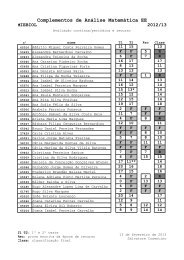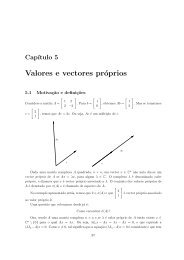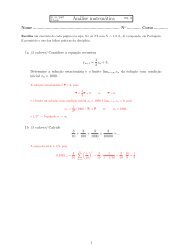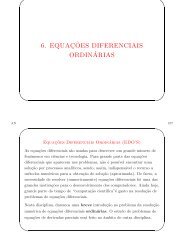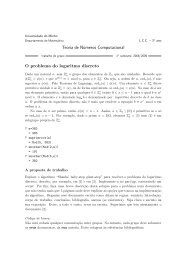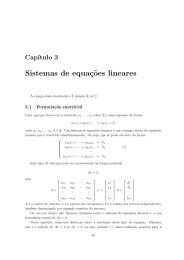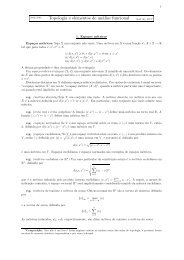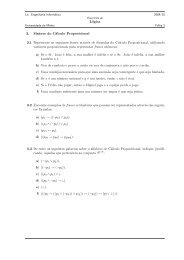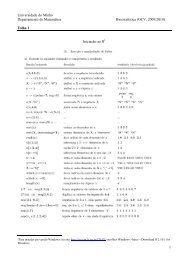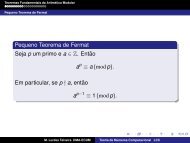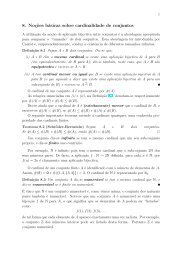My title - Departamento de Matemática da Universidade do Minho
My title - Departamento de Matemática da Universidade do Minho
My title - Departamento de Matemática da Universidade do Minho
Create successful ePaper yourself
Turn your PDF publications into a flip-book with our unique Google optimized e-Paper software.
16 ERGODICITY AND CONVERGENCE OF TIME MEANS 103<br />
different. To prove the converse, assume that the invariant measure µ is not ergodic, hence there<br />
exists an invariant event C such that 0 < µ (C) < 1. Let µ 0 and µ 1 be the ”conditional probability<br />
measures” <strong>de</strong>fined as µ 1 (A) = µ (A ∩ C) /µ (C) and µ 0 (A) = µ (A ∩ C c ) /µ (C c ). Clearly they are<br />
different, both are invariant, and µ = µ (C) µ 1 + (1 − µ (C)) µ 0 . □<br />
Ergodic <strong>de</strong>composition. In the first lines of the above proof, we actually showed that any<br />
two ergodic invariant measure µ and ν are either equal or ”mutually singular”, namely, if µ ≠ ν<br />
then there exists a measurable set A such that µ (A) = ν (A c ) = 1 and µ (A c ) = ν (A) = 0. This<br />
suggests that maybe any invariant measure could be ”disintegrated” along a partition whose atoms<br />
are the support of all the different ergodic measure, in other word that µ is a ”convex combination”,<br />
namely an integral, of the ergodic measures. This is true, sometimes, but both its statement and<br />
proof are quite technical: we just quote the result.<br />
Ergodic <strong>de</strong>composition theorem. Let f : X → X be a continuous transformation of the<br />
compact metrizable space X. There exists a partition P = {P e } e∈E<br />
of X (modulo sets of zero<br />
measure) into invariant measurable sets in<strong>de</strong>xed by a Lebesgue space E, and a measurable map<br />
E ∋ e ↦→ µ e ∈Prob f with values in the space of ergodic Borel probability measures and with the<br />
property that µ e (P e ) = 1 for any P e ∈ P, such that any invariant Borel probability measure µ can<br />
be written as an integral<br />
∫<br />
µ = µ e dµ (e)<br />
where µ is some probability measure on E.<br />
E<br />
Observe that the above theorem contains the statement that any continuous transformation of<br />
a compact space admits at least one ergodic Borel probability measure.<br />
16.2 Examples of ergodic maps<br />
Bernoulli shift. Let σ : Σ + → Σ + be the Bernoulli shift over the alphabet X = {1, 2, ..., z},<br />
and p any probability on X. The Bernoulli invariant measure µ <strong>de</strong>fined by p is ergodic. First<br />
observe that, given two centered cilin<strong>de</strong>rs C α and C β , the <strong>de</strong>finition of µ implies that there exists<br />
a time n ≥ 1 such<br />
µ ( C α ∩ σ −k (C β ) ) = µ (C α ) · µ ( σ −k (C β ) ) = µ (C α ) · µ (C β )<br />
whenever k ≥ n. In<strong>de</strong>ed, one can take n = |α| + 1, and the above reflect the ”in<strong>de</strong>pen<strong>de</strong>nce” of<br />
the different trials enco<strong>de</strong>d in the construction of the Bernoulli measure. By aditiviity, the same<br />
holds true for any couple of elements of A, the algebra ma<strong>de</strong> of finite unions of centered cilin<strong>de</strong>rs.<br />
Now, assume that A ∈ B is invariant. Since any Borel set A ∈ B can be aproximated in measure<br />
by an elements of A, given any ε > 0 one can find an A ε ∈ A such that µ (A∆A ε ) < ε. Using the<br />
above result, we can find an n ≥ 1 such that<br />
µ ( A ε ∩ σ −n (A ε ) ) = µ (A ε ) · µ ( σ −n (A ε ) ) = µ (A ε ) 2<br />
where the last equality comes from invariance of µ. Then, observe that the symmetric difference<br />
between A ∩ σ −n (A) and A ε ∩ σ −n (A ε ) is contained in (A∆A ε ) ∪ σ −n (A∆A ε ). This gives<br />
∣ µ<br />
(<br />
A ∩ σ −n (A) ) − µ ( A ε ∩ σ −n (A ε ) )∣ ∣ ≤ µ (A∆A ε ) + µ ( σ −n (A∆A ε ) )<br />
≤<br />
2 · µ (A∆A ε ) < 2ε<br />
which, together with<br />
∣ ∣∣µ (A) 2 − µ (A ε ) 2∣ ∣ ∣ ≤ 2 · µ (A∆Aε ) < 2ε<br />
gives<br />
∣ ∣∣µ (A) − µ (A)<br />
2 ∣ ∣ ∣ < 4ε<br />
Since ε > 0 was arbitrary, we just showed that the measure of any invariant Borel set A satisfies<br />
µ (A) = µ (A) 2 , hence it is either 0 or 1. Observe that this proof is very similar to the argument<br />
in the Kolmogorov zero-one law for tail events in the theory of stochastic processes.



